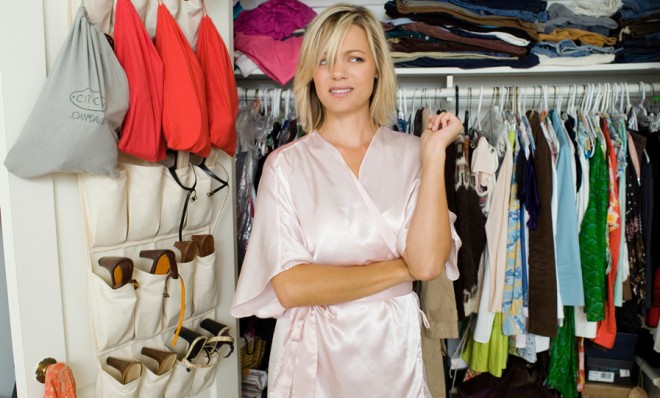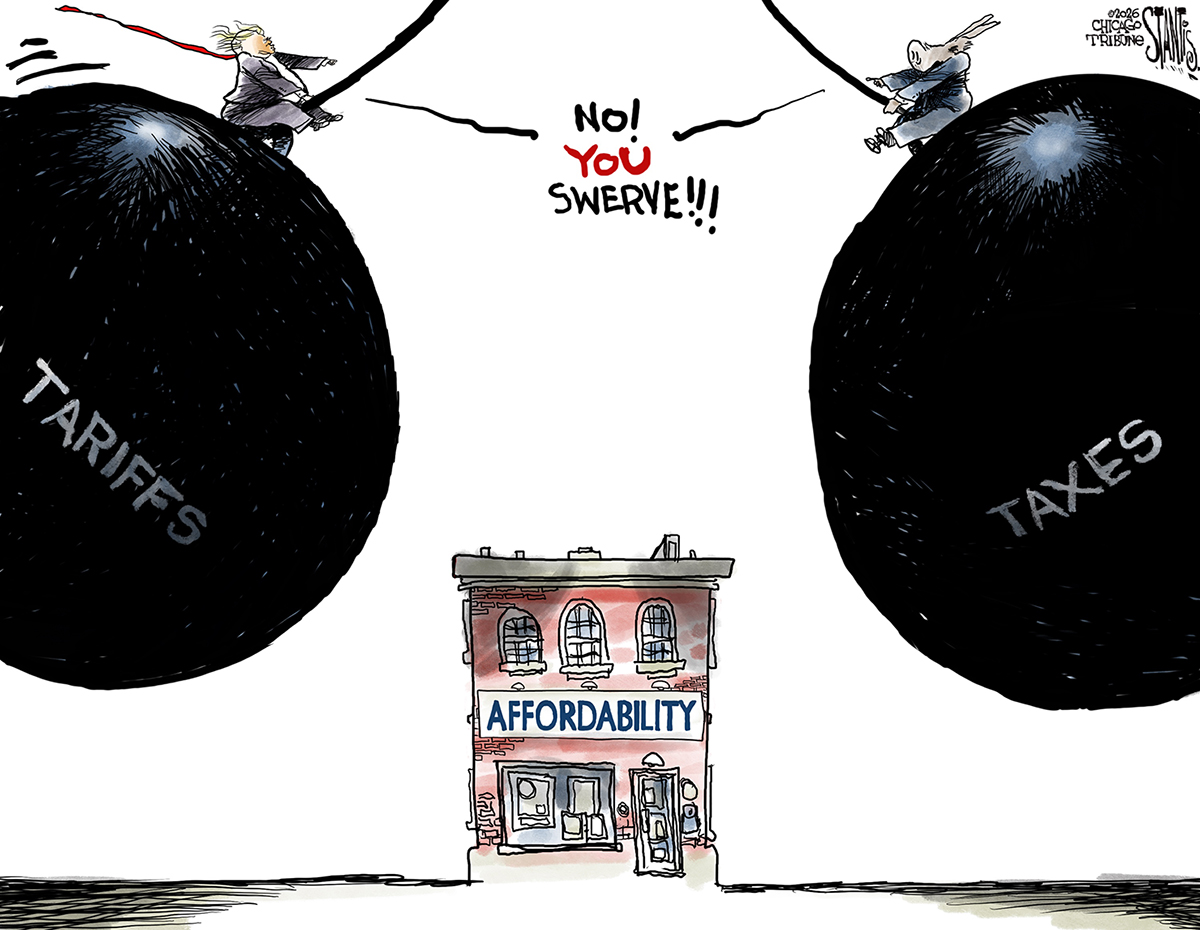How to save money by shopping your closet
Two stylists help you maximize the clothes you already own

Here's a question for anyone on a budget: How much of your income should you set aside for new clothes?
Most financial planners and budgeting sites provide a similar answer: You should be spending only about 4 to 5 percent of your post-tax household income on clothing, assuming you don't have any debt.
Let's break that down. If you make $40,000 a year, and take home about $28,000 after taxes, you should be spending around $1,400 or less a year on clothes.
The Week
Escape your echo chamber. Get the facts behind the news, plus analysis from multiple perspectives.

Sign up for The Week's Free Newsletters
From our morning news briefing to a weekly Good News Newsletter, get the best of The Week delivered directly to your inbox.
From our morning news briefing to a weekly Good News Newsletter, get the best of The Week delivered directly to your inbox.
That's not much.
I explained this to two stylists, Jen Rade and Jill Bream, and they both agreed: The first place you should go shopping is your own closet. A lot of people — girls and guys alike — wind up spending a lot of money on clothing when they have a whole closet full of stuff they almost never wear. And often the problem isn't that the clothes are bad — it's that we don't know what to match them with.
Here, a guide to helping you save money by shopping your closet:
Step 1: Organize
A free daily email with the biggest news stories of the day – and the best features from TheWeek.com
You can't do anything until you know what you have. If your closet is a dark, dusty mess, take everything out, and put it back in in an organized way.
Do it by color, sleeve length, style — whatever works. "When you know what you have, you can start making choices," says Rade.
Bream suggests you lay your accessories on the bed, and get your shoes out where you can see them. "People forget that you need to see your clothes in order to wear them," she says. "Go buy those little battery powered lightbulbs from Staples, if you need."
Step 2: Assess
Once everything is visible, it's time to "take a hard look at what you don't wear, and try to figure out why you don't wear it," says Rade.
Chances are, it's because you don't like the way it fits.
Maybe the pants are too long for your favorite shoes. Maybe you feel like the boot-cut jeans are unflattering. Maybe your skirts don't fall at the most flattering place on your leg. Or you like a blouse, but you hate the shoulder pads, and it's too boxy, and the neck's too high.
Guess what? All that stuff is fixable. Your tailor isn't just there to hem your pants and take in your jackets. Jean legs can be narrowed, necks scooped out, built-in shoulder pads removed. Assemble a pile, decide what needs to be changed, then find a tailor who's affordable and good. (If you don't have one, ask your well-dressed colleagues and friends.)
When making this pile, Bream says it's important to "think about what works on your body, not about trends."
"Don't be too quick to throw stuff away," she says. "Fashion is cyclical. Stuff comes back."
Step 3: Do some math
Once everything that fits weird is in a pile, you'll probably still have a few extra pieces that you're not wearing for some mysterious reason.
"If you're not wearing something because you're a little scared of it, try it out in different ways," says Bream.
Rade puts it like this: "People tend to think in terms of A+B, not A+C." What she means is that people tend to just match the obvious — gray slacks with a blue pinstripe shirt, a navy skirt with a white button-down top. That's fine — but how limiting.
"You need to look at everything individually and try it in ways you never have," says Rade. "Take one skirt and try it with six different tops. Try it with tights and boots. Find a few combinations that work for that one piece."
"A black pencil skirt is great because you can wear it with a crisp white shirt and pearls to work," she says. "But you can also wear it with a glittery top with tights and heels to dinner."
Bream agrees: "If you're used to just wearing your good shirts with jeans, try them a different way. Try them with trousers. Try belting different outfits with different width belts."
If you're a little style-challenged, get help for this part. Invite over a friend who both looks good and is known for being honest. No "yes" friends.
Step 4: Focus on the classics
Once you have a pile for the tailor, and you're done mixing and matching, it's time to make a list of what you need. Chances are, it will be shorter than you thought it would be.
This step is all about filling in the gaps. "If you have mostly casual clothes, you might need a jacket and a skirt," says Bream. "If you have mostly work clothes, you might just need good T-shirts." She recommends Madewell T-shirts for women.
For this part, think classics. If you don't have a classic black pencil skirt, that's a smart item to buy. Theory has great pencil skirts, but if you can't afford that, she also recommends Banana Republic. Or try vintage — "that's more ecological," says Rade.
For men, the equivalent item is nice charcoal slacks or chinos, which you can also get at Banana Republic. Or it might be one good pair of dark jeans. You can wear those with T-shirts, sweaters, button-downs, blazers, anything, says Rade.
For this part, don't worry about about trends, even if what you need is jeans. "There's no right or wrong jean anymore," Bream says. "Get the fit that works on your body and ignore everything else."
Bream says a lot of people are missing a good jacket or a blazer that can be layered with anything.
And ladies, when buying classics, think about skipping Forever 21. "If you spend a little more, it will fit you a little better, and last a little longer," she says.
Just as importantly, Forever 21 only takes exchanges. "Sometimes you try something in the store and it's great, but then you get it home and it doesn't quite work," Bream says. "So only buy clothes that can be returned. Never be scared of returning."
Step 5: Consider the flourishes
Finally, there are certain items that aren't basics, but which can hold an outfit down. For a woman, that might be a great pair of leopard pumps. "Leopard is a great unifier — it goes with everything," says Rade.
The point is that every stylist from here to Bengal will tell you to buy classics, but for a lot of us, "one great funky thing can spruce up all your clothes," says Rade. It just has to be the right thing.
Bream agrees that animal prints are great. She also likes camo. Another idea is to get one great pair of patterned pants, because you can wear them with all your plain tops.
For a guy on a budget, Rade says to go to a vintage store and invest in some fun ties.
Carmel Lobello is the business editor at TheWeek.com. Previously, she was an editor at DeathandTaxesMag.com.
-
 Political cartoons for January 18
Political cartoons for January 18Cartoons Sunday’s political cartoons include cost of living, endless supply of greed, and more
-
 Exploring ancient forests on three continents
Exploring ancient forests on three continentsThe Week Recommends Reconnecting with historic nature across the world
-
 The rise of the spymaster: a ‘tectonic shift’ in Ukraine’s politics
The rise of the spymaster: a ‘tectonic shift’ in Ukraine’s politicsIn the Spotlight President Zelenskyy’s new chief of staff, former head of military intelligence Kyrylo Budanov, is widely viewed as a potential successor